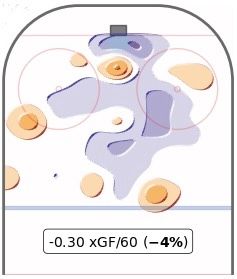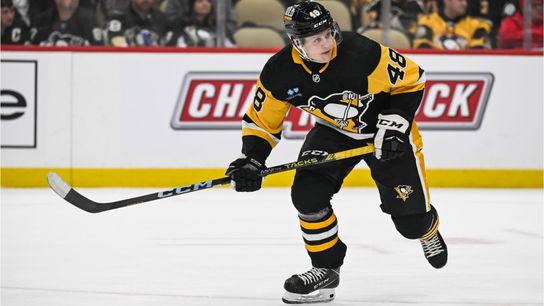BOSTON -- With Bryan Rust returning to the Penguins' lineup Tuesday for the first time since being injured on Dec. 6, the Penguins had to make some tweaks to their personnel groups.
The top power play unit remained Erik Karlsson, Sidney Crosby, Evgeni Malkin, Jake Guentzel and Rickard Rakell. Rust joined the second unit with Kris Letang, Reilly Smith, Lars Eller and Jeff Carter.
The player bumped entirely from the power play as a result was Valtteri Puustinen. Puustinen was first on the second unit since being recalled on Dec. 8, and was bumped up to the top unit the next game on Dec. 12. That was the night the Penguins ended a 37-opportunity scoreless drought on the man advantage, when Guentzel scored 1:12 into the game, assisted by both Crosby and Puustinen:
— DK Pittsburgh Sports (@DKPSmedia) December 13, 2023
Since Rakell returned from his upper-body injury on Dec. 18, Puustinen started being taken off the top unit. Puustinen had a couple of games still up with the top unit, then it started slowly -- putting Rakell up there on a five-on-three instead, at first. Eventually, Rakell replaced Puustinen entirely.
Now that the Penguins' complement of power play forwards is fully healthy, Puustinen is the odd man out. And of course, that means that it's time to bring out the pitch forks, because Puustinen single-handedly fixed the power play and is obviously bumped off for being the youngest guy out there. Right?
Not quite. Let's what the numbers actually show:
• Since Puustinen was recalled on Dec. 8, the Penguins have had 10 different forwards average at least 30 seconds per game on the power play -- the aforementioned nine, plus Vinnie Hinostroza, who saw 3:22 total over five games before being re-assigned to Wilkes-Barre/Scranon.
• Puustinen himself has played 31:49 on the power play in those 11 games, and the vast majority of that (a little over 27 minutes) was with the top unit alongside Crosby, Guentzel, Malkin and Karlsson. The other four or so minutes came with the second unit.
• That single secondary assist Puustinen got in his first opportunity with the top unit was his only point on the power play in his 31:49. Two of the 10 other forwards have no points -- Hinostroza (in 3:22) and Rust (in :31). Three forwards also have a single power play point in that span -- Rakell (a secondary assist in 24:40), Eller (a goal in 15:31), and Carter (a goal in 17:18).
• Yeah, but even if Puustinen hasn't been getting the goals or assists himself, he's doing things that make the power play better, right? That's not what the data says.
• Looking at the rate of shot attempts taken when each player is on the ice (by an Penguins player, not just that player specifically), Puustinen's on-ice rate of shot attempts for ranks last among the 10 forwards, at 101.78/60. The top three -- Rakell (148.38/60), Eller (127.60/60) and Carter (124.86/60). More shot attempts is good regardless of if they're hitting the net or getting blocked or going wide -- it creates more movement as players react.
• Looking at the same stat, just with unblocked shot attempts (so, just shots on goal and shot attempts that go wide), Puustinen's on-ice rate is 79.16/60, next-to-last, trailing only Smith's 77.53/60. The top three are Rakell (116.76/60), Rust (116.13/60) and Malkin (97.47/60). Obviously Rust's numbers are hard to put much weight into given that we're looking at a sample size of 31 seconds in this timeframe.
• We can narrow this all down even further to only shots on goal. Puustinen's on-ice rate is again No. 10 of 10 here, with 60.31/60. The top three are Rust (116.30/60, again this in particular is probably not sustainable), Rakell (75.41/60) and Hinostroza (71.29/60). Given that Rust's numbers are a little wonky and Hinostroza isn't here, it's worth mentioning that Eller is No. 4 at 69.60/60.
• Looking at only high-danger shot attempts, Puustinen's on-ice rate is No. 9 of 10 at 18.85/60. No. 10 is Rust, because the Penguins didn't record a high-danger attempt in the 31 seconds he saw on the power play on Tuesday. The top three in this category are Rakell (46.22), Hinostroza (35.64/60) and Malkin (32.86/60). Not counting Hinostroza, Eller would be next at 30.93/60.
• Now looking at expected goals (a detailed explanation of which is within this recent story I did, the short of it is that it takes quality of scoring chances into account), Puustinen is No. 9 of 10 at 7.59/60, trailed by only Rust's 6.01/60. The top three are Rakell (14.28/60), Malkin (11.03/60) and Eller (10.76/60).
• Puustinen has been on the ice for some actual goals though on the power play with five. Only Malkin, Guentzel and Crosby have been on the ice for more, at five. Taking into account ice time, Puustinen has been on the ice for the highest rate of goals (aside from Hinostroza being on the ice for one goal in 3:22, which is skewing the data). Those five power play goals Puustinen was on the ice for came over three games -- that Dec. 12 game vs. the Coyotes, two the following night in Montreal, then two on Dec. 18 vs. the Wild. The Wild's penalty-kill ranks 30th in the league, and the Canadiens' penalty-kill ranks 31st, so it's hard to put too much stock into those two games that saw two power play goals scored with Puustinen on the ice. No power play goals were scored with Puustinen on the ice in his last five games playing on a power play unit.
• One explanation here is that the Penguins' shooting percentage with Puustinen on the ice on the man advantage is abnormally high. For the players who have been healthy during this 11-game span we're looking at (so, no Rust or Rakell) everyone's on-ice shooting percentage is between 10-13% except for Puustinen. The shooting percentage when Puustinen was on the ice was 15.64%. It's hard to attribute that to anything specifically that Puustinen is doing himself, especially since they aren't his shots. Usually, when a shooting percentage is too high or low over a stretch, it's just a matter of luck and eventually regresses to the mean.
• In the interest of covering all bases, Puustinen's on-ice ranking among forwards on the power play for the entire season isn't much different. He's eighth in on-ice shot attempts, sixth in unblocked shot attempts, sixth in shots on goal, 14th in high-danger shot attempts, ninth in expected goals for.
• To sum it all up in a nice pretty picture, this visualization from HockeyViz shows Puustinen's isolated impact on the power play and taking into account the quality of teammates, competition and usage he's with. Where there is orange, there are unblocked shot attempts taken above the league-average rate when Puustinen is on the ice. Where there is blue, the unblocked shot attempts are below the league-average rate. That's not for Puustinen as an individual, just what is happening when he is on the ice. The end result is that with Puustinen on the ice on the power play, the Penguins' expected goals for rate drops by .30, or 4%:

HockeyViz.com
• One thing to note: Handedness matters when making the personnel decisions. Puustinen for Rakell on the top unit, or Puustinen for Rust on the second unit was an easy swap because they're all right-handed. They're also the only right-handed power play options other than Carter, who has a bit of a different role given that he's the net-front guy on the second unit. Swapping Puustinen for anyone else isn't as simple of a change.
• So, what does this all mean?
None of this is to say that Puustinen was in any way a detriment to the power play himself, but for whatever reason, things were typically at their least best over this stretch when he was on the ice on the man advantage. And that's likely why the decision was made to take him off the second unit on Tuesday. It just wasn't working anymore. But perceptions are easily influenced by the good first impression he made, or just by him being the shiny new, young toy in the lineup.
I think Puustinen's a great player. I think he has a future as an NHL player, and that will eventually include him being on a power play and contributing. Having actually watched him play for Wilkes-Barre/Scranton for a few years now, it's obvious the tools are there and elements like that shot can transfer to the NHL level. That will come in time. To act like it's some grave injustice that he's not presently on a power play unit now (which could always change moving forward) just isn't right.
The first time I talked to Puustinen back in 2020 when he was still in Finland, he said (through then-Penguins goalie prospect Emil Larmi, acting as translator) that "development and results aren’t always linear" regarding the up-and-down path he had back in the Finnish league. He was making strides over there, even though the path wasn't always a straight shot forward.
That's a helpful reminder now as Puustinen works to carve himself out a role at the NHL level.


